I’ll start with two assumptions: It wasn’t for any of the reasons they’ve given. The "they" is Karl Rove [WH OPA] working through Harriet Miers [WHCO]. These are in the range of "we hold these truths to be self evident."
On April 7, 2006, Karl Rove made a speech to the National Republican Lawyers Association in which raled against the judiciary as usual. Then he said, "We are, in some parts of the country, I’m afraid to say, beginning to look like we have elections like those run in countries where they guys in charge are, you know, colonels in mirrored sunglasses" implying widespread voter fraud. He also talked about there being eleven States that were on the edge between Blue and Red, something he’d talked about before. He and the President have both alledged voter fraud as a big problem. We think that part of the reason these Attorneys were replaced was to put U.S. Attorneys in place who would push voter fraud cases in these "swing States." Beside the fact that they talk endlessly about this voter fraud [even though there are recent reports that says it is negligable], in the last year, U.S. Attorneys have been replaced in 9 out of 11 of the States he targeted. So one motive for firing the U.S. Attorneys was a plan to get people who will prosecute more voter fraud, intimidate poor and Minority voters [Democratic voters], and maybe have U.S. Attorneys in place if there are close elections [like 2000].
-
In December 2005, Sharon Y. Eubanks resigned in protest from the Justice Department. After winning against Phillip Morris, she was ordered to lower damages from $130 billion to $10 billion by Associate Attorney General Robert D. McCallum who had previously been with the firm that defended Phillip Morris. He was later appointed Ambassador to Australia.
- Paul Charlton was the U.S. Attorney in Arizona [in the group recently fired.] He had begun the investigation in the dealings of Representative Rick Renzi in a shady land deal. The F.B.I. raided Renzi’s home last week.
- Bud Cummins, U.S. Attorney from Arkansas was told he was fired to make room for Tim Griffin, a friend of Karl Rove’s and a up-and-coming Republican Operative.
- In November 2006, Debra Wong Yang, U.S. Attorney investigating Representative Jerry Lewis for corruption resigned, being paid $1.5 million dollars to go to work for the firm defending Representative Lewis.
- Carol Lam had successfully prosecuted Duke Cunningham and was in the process of indicting several more such cases when she was fired. Hers is the most outrageous of the firings.
- Rachel Paulose is a story unto herself. See my previous post about her. She’s the one with the "coronation" whose staff resigned.
- David Iglesias of New Mexico was apparently fired because he wouldn’t pursue corruption charges of a Democrat at the request of Senator Pete Domenici and Representative Heather Wilson – both of whom pressured him and ultimately appealed to Karl Rove and probably President Bush.
- Steven Biskupic was apparently on the firing list, but was removed when he prosecuted a State Emplyee, Georgia Thompson, for giving a contract to one of the Democratic Governer’s contributers. The case was reversed and Biskupic may be in some really hot water.
- John McKay was perhaps fired for failing to pursue voter fraud cases in the Governer’s race.
So beside the wish to get control of the U.S. Attorneys in the "swing States," wanting to press their voter fraud agenda, it appears that the firings may have also had a specific strong political agenda that was well over on the dark side.
I, personally, am not sure we’ve reached the bottom of Karl Rove’s motives. They went to a lot of trouble and took a surprising risk to bring this off. I suspect that there’s even more to this story, as yet unrevealed.
What about the change in the Patriot Act?
Attorney General, Alberto Gonzales, and his Chief of Staff, Kyle Sampson, deny that that they tried to circumvent the Senate in appointing new U.S. Attorneys using the provisions added to the Pastriot Act in March 2006. It’s a bit hard to imagine that is even possibly true, but I suppose it’s worth documenting why. In his initial email of January 9, 2006, Kyle Sampson writes [to Harriet Miers]:
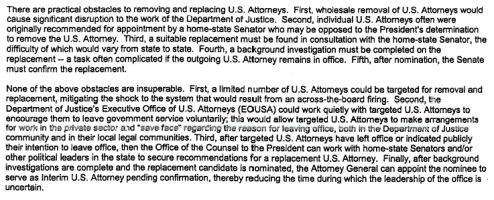
It’s a pretty good plan – one they probably used, given the number of convenient resignations that came along in the ensuing months. But then, in March, a provision was added to the Patriot Act at the 11th hour in a Committee meeting [no one owns up to authoring it, or even knowing about it]. For reminders, here it is:
SEC. 502. INTERIM APPOINTMENT OF UNITED STATES ATTORNEYS.
… I strongly recommend that, as a matter of policy, we utilize the new statutory provisions that authorize the AG to make USA appointments. We can continue to do selection in JSC, but then should have DOJ take over entirely the vet and appointment. By not going the PAS route, we can give far less deference to home-State Senators and thereby get (1) our preferred person appointed and (2) do it far faster and more efficiently, at less cost to the White House. What say you?
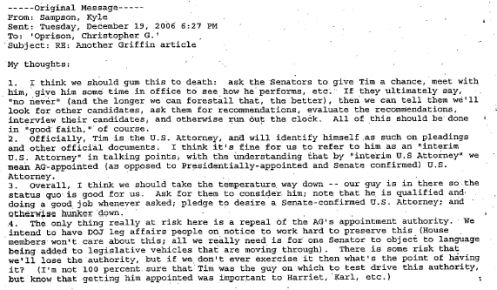
Sampson hems and haws, but it felt like checkmate to me.
And if that were not enough, there’s the piece I mentioned several days ago. After the Midterm Election defeat, Sampson added another Step to his Plan:
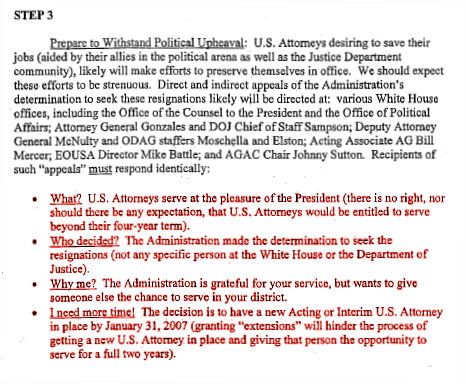
Any rational reading of these lines would make it clear that he was saying the Interim U.S. Attorney would serve out the rest of the Administration’s term of office. The later Step about nominations was a smoke screen. I conclude they changed the Patriot Act in order to facilitate the Attorney firings and evade Judicial Appointments or home-State Senator problems or even Senate Confirmation.
What was "the process?"
Last week, Attorney General Alberto Gonzales kept saying two things – "I don’t recall" and "I was involved in the process." He had no recall of anything specific, but he harped on being part of the "process" – his sole defense against the charge of incompetence. What was this "process" exactly? If it’s what it seems to have been, and right prevails, Albert Gonzales might find himself in a courtroom saying that he had nothing to do with this precious "process."
 While we think of Karl Rove as part of the Bush Administration, that’s not altogether correct. Karl Rove is the mastermind of the Republican Party. If anything, Bush is the public persona, created by Rove. I’m not even sure Rove is a neoconservative. That’s Cheney’s ballpark. Rove is the National Republican Party’s soul. So I think the "process" begins with Karl Rove. He got Bush elected twice, and both times involved influencing the vote – allying with the Religious Right and probably tweaking the voting system in not so savory ways. I doubt that he plans to just fade away with George W. Bush.
While we think of Karl Rove as part of the Bush Administration, that’s not altogether correct. Karl Rove is the mastermind of the Republican Party. If anything, Bush is the public persona, created by Rove. I’m not even sure Rove is a neoconservative. That’s Cheney’s ballpark. Rove is the National Republican Party’s soul. So I think the "process" begins with Karl Rove. He got Bush elected twice, and both times involved influencing the vote – allying with the Religious Right and probably tweaking the voting system in not so savory ways. I doubt that he plans to just fade away with George W. Bush.
Over and above his plans for 2008, he’s loyal to elected Republicans, and they’ve been taking a beating from the U.S. Attorneys. He almost took one himself [barely saved by the loud mouth of Viveca Novak]. So my guess is that he was motivated to unseat the troublesome U.S. Attorneys [including Patrick Fitzgerald] and get people in place that might help him swing the vote in 2008. His vehicle was Harriet Miers and the Karl Rove clone – Kyle Sampson [and maybe Monica Goodling]. I think Alberto Gonzales is mostly a figurehead, wearing the crown of the Attorney General, but not carrying the Scepter. After the 2004 election, the Plame case, and the corruption scandals, he set his sights on the U.S. Attorneys. We know he felt like it was the scandals that were killing him at the polls. So he inquired through Miers how to make some changes.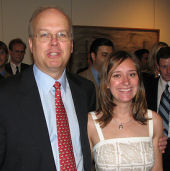
Sampson jumped on the question, and outlined both a strategy and the problems – Rove’s kind of thinking. So, using Sampson’s lead, they got the way things were done changed by sneaking a piece into the Patriot Act. Sampson was good at such plans, and by the time of the Midterm Elections, everything was in place to make a move literally on the day after the elections. I think Karl Rove actually thought he was going to pull it off in 2006, but for once, it didn’t work out like he planned. So the U.S. Attorney Plan went on hold for a bit. Sampson was biting at the bit to surge ahead, revising his plans, revising his lists, girding up for the new challenge.
To go or to not to go? That is the Question
There were certainly forces, surely obvious to Karl Rove, that argued that it was dangerous to proceed, mainly a new Democratic Congress full of frustrated legislators biting at the bit to go after the Administration full tilt. On the other hand, there were lots of Republicans under threat of prosecution. And the 2006 loss made the coming 2008 Elections loom even more ominously in the future. But Karl Rove didn’t get were he was by holding back. His M.O. is to drive headlong into the opposition – "brandish steel" as he once said. His allies at the Department of Justice were strong, loyal, and willing. They adjusted the Plan to adapt to the election loss. But I expect it was a close call, even for the ambitious and arrogant Karl.
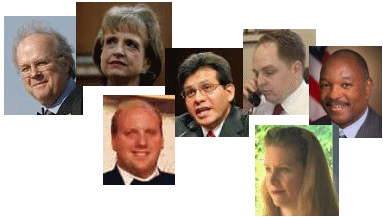
Sorry, the comment form is closed at this time.